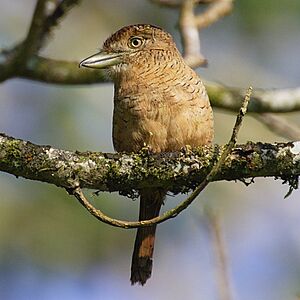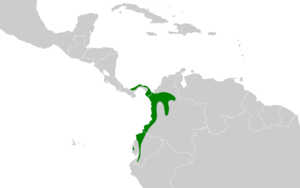Barred puffbird facts for kids
Quick facts for kids Barred puffbird |
|
|---|---|
 |
|
| Conservation status | |
| Scientific classification | |
| Genus: |
Nystalus
|
| Species: |
radiatus
|
 |
|
| Synonyms | |
|
Ecchaunornis radiatus |
|
The barred puffbird (Nystalus radiatus) is a cool bird that lives in parts of Central and South America. It's known for its unique look and interesting calls. This bird belongs to a family called Bucconidae, which includes other puffbirds, nunlets, and nunbirds. You can find it in countries like Panama, Colombia, and Ecuador.
Contents
About the Barred Puffbird's Name
Scientists give every animal a special name. This helps everyone know exactly which creature they are talking about. For a while, some scientists thought the barred puffbird belonged to a different group called Ecchaunornis. However, they later decided it fits better with the Nystalus group.
This bird is also considered "monotypic." This means it's the only species in its group without any official subspecies. Sometimes, you might hear about a "N. r. fulvidus" type, but scientists think this is just a color variation, not a separate subspecies.
What Does a Barred Puffbird Look Like?
The barred puffbird is about 22 centimeters (8.7 inches) long. It weighs around 63 grams (2.2 ounces), which is about as much as a small apple.
Feathers and Colors
- Head: Its head has a blackish crown with dark reddish-brown stripes.
- Neck: The upper part of its neck is black, while the lower part is yellowish-red.
- Back and Wings: The rest of its back and wings are a dark chestnut color. They have thin black bands across them.
- Tail: The tail is long, narrow, and chestnut-colored with thin black bands.
- Face and Belly: Its chin is whitish. The face and belly are a pale reddish-brown. They have fine blackish stripes, except for the very center of the belly.
Other Features
- Beak: Its beak can be grayish-yellow or even blackish.
- Eyes: The eyes are a creamy yellow color.
- Feet: Its feet are greenish-gray.
There's also a "fulvidus" color type. This bird is a deeper reddish-brown all over.
Where Do Barred Puffbirds Live?
The barred puffbird lives in a specific area. You can find it from central Panama, through northern and western Colombia, and into western Ecuador.
Their Favorite Places
These birds like to hang out in the lower parts of semi-open areas. This includes:
- The edges of humid and wet forests.
- Areas with plants along streams.
- Open spaces with a few scattered trees.
- The sides of forest trails.
In Ecuador, people have even seen them perched on wires in farm areas. They usually live at elevations up to 900 meters (2,950 feet) above sea level. However, they have been seen higher up in some places. For example, near Mindo, Ecuador, they've been recorded as high as 1,675 meters (5,495 feet). One was even seen at 1,550 meters (5,085 feet) in Colombia.
How Barred Puffbirds Behave
What Do Barred Puffbirds Eat?
We don't know a lot about exactly how barred puffbirds find their food. However, other puffbirds usually hunt by sitting on a perch. Then, they quickly fly out to catch their prey.
Their diet includes large insects. They also eat small lizards.
How Do Barred Puffbirds Raise Their Young?
Only one barred puffbird nest has ever been described. It was a cup made of dead leaves. This nest was inside a round chamber. The chamber was at the end of a narrow tunnel. The tunnel was dug into a clay bank. Plants partially shaded the nest. This particular nest had two young birds that were already quite big.
What Does a Barred Puffbird Sound Like?
The barred puffbird has a very unique song. It sounds like a long, slow, and very human-like "wolf-whistle." It goes "phweeeeeet-weeeeeeuuuu." It can also sound like the sound is coming from far away, even when the bird is close. When they are near their nest, they make low-pitched "werr" and "werr werr woo" calls.
Are Barred Puffbirds in Danger?
The IUCN (International Union for Conservation of Nature) checks on how many animals are left in the wild. They have said the barred puffbird is a species of "Least Concern." This means they are not currently in danger of disappearing.
Scientists believe there are at least 50,000 adult barred puffbirds. However, their numbers might be slowly going down. Luckily, they live in several protected areas in Colombia and Ecuador. These protected places help keep them safe.


